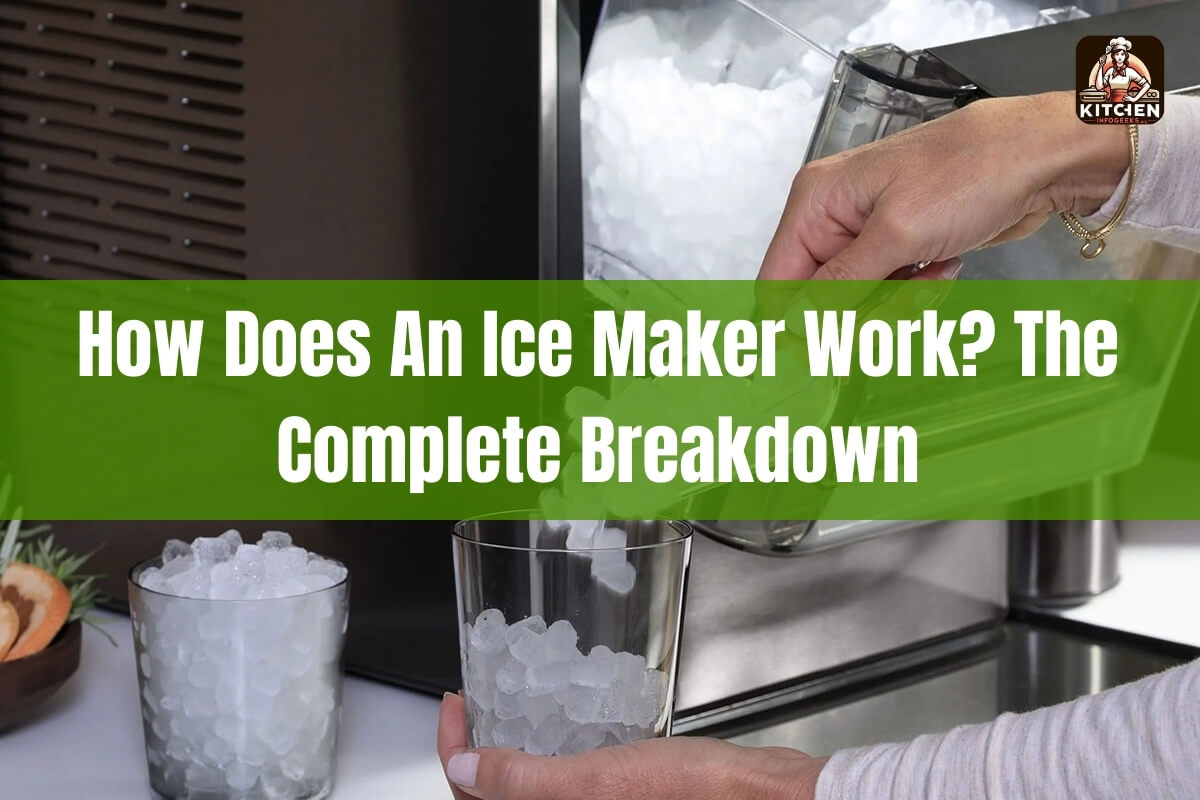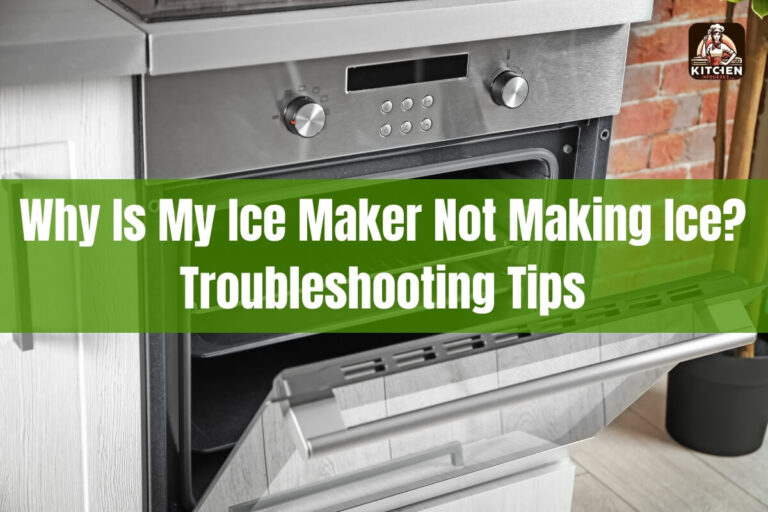
Having ice cubes readily available is a luxury we often overlook. Gone are the days of frantically buying ice bags for guests or patiently waiting for ice trays to freeze. Simply open your freezer, and voila – an endless supply awaits. But have you pondered, how does an ice maker work? This handy appliance automates freezing water into ice cubes through ingenious engineering and refrigeration.
This guide uncovers the inner mechanics of ice makers – the vital components, refrigeration cycle, different types, and essential installation/maintenance tips. Get ready to demystify how these machines effortlessly craft those chilled cubes enhancing our beverage delight.
Understanding the Basic Ice Making Process
At its core, an ice maker follows a cyclical process of freezing water and harvesting the resulting ice cubes. It’s an automated version of the age-old method of manually pouring water into ice trays and placing them in the freezer. However, the magic lies in the intricate design and orchestration of various components that make this process seamless and continuous.
The cycle typically begins with a water supply line filling the ice maker’s mold or tray with fresh water. As the refrigeration system kicks in, the water gradually freezes into the desired ice cube shapes. Once frozen, a harvesting mechanism dislodges the ice cubes from the mold, transferring them into a storage bin or dispenser. The cycle then repeats itself, ensuring a constant supply of fresh ice cubes.
The Key Components of an Ice Maker
While the overall process may seem straightforward, the inner workings of an ice maker involve several critical components working in harmony. Let’s explore these key players that bring the ice-making magic to life.
The Compressor
The compressor is the heart of the refrigeration system, responsible for pressurizing and heating the refrigerant gas. This compressed, high-pressure gas is vital for the subsequent cooling and ice formation stages.
The Condenser
The condenser plays a crucial role in cooling and liquefying the hot, high-pressure refrigerant gas from the compressor. It does this by dissipating the heat from the gas, typically through air-cooled or water-cooled systems. As the gas cools, it condenses into a liquid state, ready for the next phase of the cycle.
The Expansion Valve
Also known as the Thermostatic Expansion Valve (TXV), this component rapidly expands the high-pressure liquid refrigerant, causing a drastic drop in temperature. This adiabatic cooling process is essential for lowering the refrigerant’s temperature to the point where it can absorb heat from the surrounding environment and freeze the water in the ice maker’s mold or tray.
The Evaporator
The evaporator is where the actual freezing magic happens. As the low-pressure, low-temperature liquid refrigerant passes through the evaporator coils or plates, it absorbs heat from the water in the ice mold or tray. This heat absorption causes the refrigerant to evaporate back into a gaseous state while simultaneously freezing the water into ice cubes.
Other Essential Parts
While the components mentioned above are crucial for the refrigeration cycle, other parts play vital supporting roles in the ice-making process. These include:
- Water Inlet Valve: Responsible for controlling the flow of water into the ice maker’s mold or tray.
- Water Pump: Circulates the water over the evaporator in certain ice maker designs.
- Ice Storage Bin or Dispenser: Collects and stores the freshly made ice cubes, ready for use.
- Mold or Tray: The shaped cavity where the water freezes into ice cubes.
- Harvesting Mechanism: Dislodges the frozen ice cubes from the mold or tray, transferring them to the storage bin or dispenser.
Ice Maker Refrigeration Cycle Explained
Now that we’ve understood the key components, let’s delve into the intricate refrigeration cycle that powers the ice-making process. This cycle involves the continuous flow and state changes of the refrigerant as it moves through the different components.
- Compression: The compressor compresses the low-pressure, gaseous refrigerant, increasing its pressure and temperature.
- Condensation: The hot, high-pressure gas then enters the condenser, where it is cooled and condenses into a high-pressure liquid state.
- Expansion: The high-pressure liquid refrigerant passes through the expansion valve, where it rapidly expands and cools, becoming a low-pressure, low-temperature liquid.
- Evaporation: In the evaporator, the low-pressure, low-temperature liquid refrigerant absorbs heat from the surrounding environment, including the water in the ice mold or tray. This heat absorption causes the refrigerant to evaporate back into a gaseous state, while simultaneously freezing the water into ice cubes.
- Repeat: The low-pressure, gaseous refrigerant then returns to the compressor, and the cycle repeats continuously, enabling a steady production of ice cubes.
This continuous cycle of compression, condensation, expansion, and evaporation is the heart of the ice maker’s refrigeration system, ensuring a consistent supply of fresh ice cubes.
Types of Ice Makers
While the principles of ice making remain the same, there are different types of ice makers designed to cater to various needs and applications. Let’s explore some of the most common varieties.
Residential Ice Makers
Residential ice makers, commonly found in household refrigerators, are designed to provide a convenient supply of ice for personal or small-scale use. These ice makers automate the process of freezing water into ice cubes, eliminating the need for manual ice trays.
The ice production capacity of residential ice makers is relatively modest, typically ranging from a few pounds to around 25 pounds of ice per day. The harvesting mechanism in these units is often a simple ejector arm or rake that dislodges the ice cubes from the mold and transfers them to a storage bin or dispenser.
Commercial Ice Makers
For businesses and establishments with higher ice demands, commercial ice makers are the go-to solution. These heavy-duty units are designed to produce large quantities of ice continuously, ensuring a steady supply for restaurants, bars, hotels, and other commercial establishments.
Cube Ice Makers
Cube ice makers, as the name suggests, produce individual, clear ice cubes. These units typically employ a specialized process called “cube-on-the-sweep” or “cuber” to build up layers of ice on an evaporator plate or cylinder. Once the desired cube size is achieved, a harvesting mechanism dislodges and scoops the cubes into a storage bin or dispenser.
Cube ice makers are renowned for producing clear, solid ice cubes that melt slowly, making them ideal for beverages, ice buckets, and other applications where appearance and slow melting are desirable.
Flake Ice Makers
Flake ice makers, on the other hand, produce soft, chewable ice flakes or nuggets. Instead of distinct cubes, these units freeze water onto a cylindrical evaporator, forming a thin layer of ice. An ice crusher then breaks this layer into small, flake-like pieces, which are collected in a storage bin.
Flake ice is often preferred for its ability to chill and maintain the temperature of ingredients or products effectively. It finds widespread use in various applications, such as food displays, beverage coolers, and medical or scientific cooling needs.
Ice Maker Installation and Maintenance
Proper installation and regular maintenance are crucial for ensuring your ice maker operates at peak efficiency and extends its lifespan. Here are some essential considerations:
Installation Requirements
- Water Supply: Ice makers require a dedicated water supply line to provide a consistent flow of fresh water for ice production.
- Electrical Connection: Most ice makers need to be connected to a dedicated electrical outlet or circuit, following the manufacturer’s specifications.
- Drainage: Some ice makers may require a drainage system or floor drain to deal with excess water or condensation.
- Clearance: Ensure adequate clearance around the ice maker for proper ventilation and easy access for maintenance and cleaning.
Regular Maintenance and Cleaning
- Filter Replacement: If your ice maker has a water filter, replace it according to the manufacturer’s recommendations to ensure clean water supply and optimal ice quality.
- Cleaning: Regularly clean the ice maker’s interior components, such as the ice mold or tray, storage bin, and dispensing mechanisms, to prevent the buildup of mineral deposits, mold, or other contaminants.
- Condenser Cleaning: Clean the condenser coils or fins to remove dust and debris, allowing for efficient heat dissipation and proper cooling.
Professional Servicing: Periodic professional servicing by a qualified technician is highly recommended. These experts can thoroughly inspect, clean, and maintain all components, ensuring optimal performance and identifying any potential issues before they escalate.
Common Issues and Troubleshooting Tips
Even with proper installation and maintenance, ice makers may occasionally encounter issues. Here are some common problems and troubleshooting tips:
- No Ice Production: If your ice maker isn’t producing any ice, check the water supply line, ensure the unit is receiving power, and inspect the freezing components for any obstructions or malfunctions.
- Slow Ice Production: Slow ice production can be caused by various factors, such as a dirty condenser, clogged water filter, or a refrigerant leak. Addressing these underlying issues can help restore optimal ice production.
- Ice Clumping or Sticking: Ice cubes may clump together or stick to the mold due to mineral buildup, improper water quality, or issues with the harvesting mechanism. Regular cleaning and descaling can help resolve this problem.
- Strange Taste or Odor: If your ice cubes have an off-taste or odor, the water supply line or ice maker interior may need cleaning or disinfecting. Replacing the water filter can also help resolve this issue.
- Leaks: Water leaks can occur due to damaged gaskets, loose connections, or issues with the water inlet valve or drain line. Promptly addressing leaks is crucial to prevent water damage and ensure proper ice maker operation.
By understanding these common issues and following the manufacturer’s troubleshooting guidelines, you can often resolve minor problems and extend the lifespan of your ice maker. However, for more complex issues or if you’re unsure about the cause of the problem, it’s best to seek professional assistance.
Conclusion
How does an ice maker work? It’s a fascinating blend of engineering, refrigeration technology, and automation, all working in harmony to provide a continuous supply of frozen cubes at our fingertips. From the compressor to the condenser, expansion valve, and evaporator, each component plays a crucial role in the refrigeration cycle that enables the freezing and harvesting of ice.
Whether you have a residential ice maker in your kitchen or a heavy-duty commercial unit powering your business, understanding the inner workings of these appliances can help you appreciate the ingenuity behind their design and ensure proper maintenance for optimal performance.
By following installation guidelines, regularly cleaning and servicing your ice maker, and addressing any issues promptly, you can enjoy a steady stream of ice cubes, elevating the enjoyment of your beverages and keeping your guests refreshed. So, the next time you reach for a frosty drink, take a moment to marvel at the ingenious process that brought those ice cubes to your glass.






